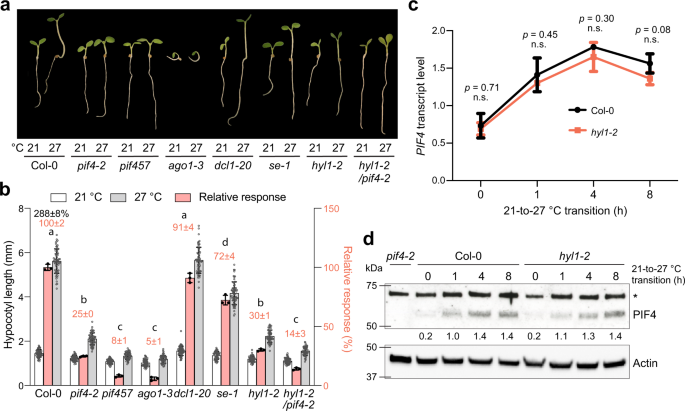作物の成長を最大化するという大きな目標のための小さな鍵 The tiny key to a major goal: maximizing crop growth
2023-03-23 カリフォルニア大学リバーサイド校(UCR)
<関連情報>
- https://news.ucr.edu/articles/2023/03/23/without-plants-cannot-respond-temperature
- https://www.nature.com/articles/s41467-023-36774-9
マイクロRNA156がオーキシン感受性を調節し、シロイヌナズナの環境変化に対応した生育可塑性を可能にする。 MicroRNA156 conditions auxin sensitivity to enable growth plasticity in response to environmental changes in Arabidopsis
Qing Sang,Lusheng Fan,Tianxiang Liu,Yongjian Qiu,Juan Du,Beixin Mo,Meng Chen & Xuemei Chen
Nature Communications Published:22 March 2023
DOI:https://doi.org/10.1038/s41467-023-36774-9

Abstract
MicroRNAs (miRNAs) play diverse roles in plant development, but whether and how miRNAs participate in thermomorphogenesis remain ambiguous. Here we show that HYPONASTIC LEAVES 1 (HYL1)—a key component of miRNA biogenesis—acts downstream of the thermal regulator PHYTOCHROME INTERACTING FACTOR 4 in the temperature-dependent plasticity of hypocotyl growth in Arabidopsis. A hyl1-2 suppressor screen identified a dominant dicer-like1 allele that rescues hyl1-2’s defects in miRNA biogenesis and thermoresponsive hypocotyl elongation. Genome-wide miRNA and transcriptome analysis revealed microRNA156 (miR156) and its target SQUAMOSA PROMOTER-BINDING-PROTEIN-LIKE 9 (SPL9) to be critical regulators of thermomorphogenesis. Surprisingly, perturbation of the miR156/SPL9 module disengages seedling responsiveness to warm temperatures by impeding auxin sensitivity. Moreover, miR156-dependent auxin sensitivity also operates in the shade avoidance response at lower temperatures. Thus, these results unveil the miR156/SPL9 module as a previously uncharacterized genetic circuit that enables plant growth plasticity in response to environmental temperature and light changes.


